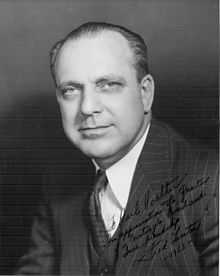Ernst A. Lehmann


Captain Ernst August Lehmann (12 May 1886 - 7 May 1937) was a German Zeppelin captain. He was one of the most famous and experienced figures in German airship travel.
Pre-war experience
Ernst Lehmann was born in 1886 in Ludwigshafen am Rhein.[1] At the age of 14, he decided that he wanted to build ships. He studied engineering at the Technische Hochschule Berlin and received his degree in 1912. By this time, he had already joined the navy and had attained the rank of naval reserve lieutenant.
Upon graduation, he began work at the Imperial Dockyards in Kiel.[1] He did not find this work satisfying so, encouraged by Dr. Hugo Eckener, he joined the DELAG to serve as pilot of the passenger airship LZ 17 Sachsen.[1] He commanded a total of 550 flights of this ship.
Service during World War I
During the First World War, Captain Lehmann commanded army airships, beginning with the Sachsen[1] and followed by the LZ XII,[2] LZ 90,[2] LZ 98,[1] and LZ 120.[1]
Post-war commercial airship travel
After the war, Captain Lehmann continued his involvement with the airships, now used for civilian purposes. He made preparations to fly the naval airship L 72 on the first transatlantic crossing of an airship in 1919.[1] Permission was denied by the German government. In 1920, he spent six months in Sweden studying the economics of an airship line between Stockholm and the Mediterranean, with a stopover in Friedrichshafen.[1] These plans were never realized.
In 1921 he spent four months in the United States to prepare for a planned New York to Chicago airship route, and in 1922 tried to negotiate with USA and England over a North Atlantic route.[1]
With the founding of the Goodyear Zeppelin Corporation in 1923, Captain Lehmann served as Vice President in charge of engineering.[1]
In 1924, Captain Lehmann was second-in-command of LZ 126 on the first nonstop transatlantic flight between the European and American mainlands. The purpose of the flight was to deliver the Zeppelin to its new owners, the United States Navy, who rechristened the ship USS Los Angeles.
In 1935, when Hermann Göring created the Deutsche Zeppelin Reederei to increase Nazi influence over zeppelin operations, Captain Lehmann was named director of the new airline.[3]
Captain Lehmann served as commanding officer on more than 100 of the flights of the Graf Zeppelin between 1928 and 1936. In 1936, he commanded 10 round-trip flights to Lakehurst on the new Hindenburg. Captain Lehmann was a skilled accordion player, which he often used to entertain passengers on long flights with renditions of Wagner pieces or German folk songs.[4]
Death
Although Max Pruss was the commanding officer of the last flight of the Hindenburg, Captain Lehmann was the most senior officer on board. He was fatally burned when the ship caught fire at Lakehurst on 6 May 1937; he died the following day.
At his death, he believed that the Hindenburg was sabotaged. He came out of the burning wreckage saying "I don't understand it." During a deathbed conversation with Commander Charles Emery Rosendahl, he said "it must have been an infernal machine."
Criticism
Lehmann was a supporter of the Nazi party, and often thought about impressing the Nazi party over safety. During the Deutschlandfahrt propaganda flight, the Hindenburg took off in gusty conditions and the ship's lower fin smashed the ground. Dr. Eckener was furious and said to Lehmann:
How could you, Herr Lehmann, order the ship to be brought out in such windy conditions? You had the best excuse in the world for postponing this idiotic flight; instead, you risk the ship, merely to avoid annoying Herr Goebbels. Do you call this showing a sense of responsibility towards our enterprise?
After Lehmann's death, Hugo Eckener blamed Lehmann for pushing Max Pruss to land the ship.
Portrayals
In the 1975 film The Hindenburg, Captain Lehmann was portrayed by Richard Dysart, although this portrayal is quite inaccurate with Lehmann appearing wary of the Nazis, whereas the real Lehmann was a well-known supporter. In the 2007 docudrama Hindenburg: The Untold Story, Polish actor Aleksander Trabczynski portrayed Lehmann. In the fictional 2011 RTL television movie of the disaster, he was portrayed by Ulrich Noethen. In this film, he supports the Gestapo in their brutal torture of Merten Kroger for the alleged murder of a passenger, but orders his release upon seeing proof of a bomb aboard the ship. During the landing approach, he pushes the landing approach and ignores Kroger's warning that putting stress on the ships frame would be dangerous, saying it's "less dangerous than a bomb going off". He is proven wrong when although the bomb is defused, the airship explodes due to static electricity.
Books
Captain Lehmann's book Zeppelin: The Story of Lighter-than-air Craft,[5] written in collaboration with Leonhard Adelt (who was on board as a guest during the Hindenburg's last flight), had recently been published in German when the Hindenburg was destroyed. An English edition, translated by Jay Dratler, was published later in 1937 with a preface and closing chapter by the American airship captain Charles E. Rosendahl.
Footnotes
References
- Lehmann, Ernst A.; Mingos, Howard. The Zeppelins. The Development of the Airship, with the Story of the Zepplins Air Raids in the World War. Chapter I GERMAN AIRSHIPS PREPARE FOR WAR (online chapter)
- Krug, Andreas. Biographie Ernst A. Lehmann. (German) retrieved 2008-07-22
External links
| Wikimedia Commons has media related to Ernst August Lehmann. |
- Ernst Lehmann Biography
- Frankfurter Hauptfriedhof: Denkmal zum Luftschiff-Unglück Frankfurt Main Cemetery: Airship-accident Memorial (German)
|